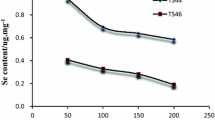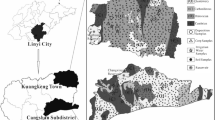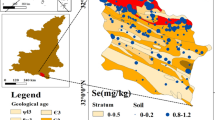Abstract
According to the 1 : 50000 scale soil geochemical survey from a several of key selenium (Se) rich areas in the traditional considered Se deficiency area of northern Hebei Province, China, the content, distribution, and the influencing factors of surface soil Se distribution in this area were determined. The Se concentration of surface soil in this area was calculated to be 0.06–3.74 mg/kg, with a mean of 0.4 mg/kg. The Se-rich (Se ≥ 0.4 mg/kg) domains are about 116.8 km2, accounting for 29.05% of the total areas. The concentration of Se in surface soils tends to decrease in the north and increase in the south. The soil Se content and distribution were affected by various factors. Soil parent rocks were the initial sources of Se, but their effects on soil Se content and distribution were limited. The Se content in surface soil had a strong positive correlation with organic carbon (Corg), S, and Fe2O3, but a weak correlation with topographic parameters. The Se content of various soil types, including meadow chestnut soil, calcareous meadow soil, gley meadow soil, and saline meadow soil, and land use types, including natural grassland and other grassland, were relatively high, mainly because of the indirect effect from abundant organic matter and high water content in soil. Additionally, the analysis result of GeoDetector showed that S and Corg were the main driving factors of soil Se distribution and the influence of other factors was limited.




Similar content being viewed by others
REFERENCES
B. Ahmed, A. Rizvi, A. Zaidi, M. S. Khan, and J. Musarrat, “Understanding the phyto-interaction of heavy metal oxide bulk and nanoparticles: evaluation of seed germination, growth, bioaccumulation, and metallothionein production,” RSC Adv. 9, 4210–4225 (2019).
C. Chang, Yin R., Wang X., Shao S., Chen C., and Zhang H., “Selenium translocation in the soil-rice system in the Enshi seleniferous area, Central China,” Sci. Total Environ. 669, 83–90 (2019).
H. X. Cheng, K. Li, M. Li, K. Yang, F. Liu, and X. M. Cheng, “Geochemical background and baseline value of chemical elements in urban soil in China,” Earth Sci. Front. 21, 265–306 (2014).
Code of Geochemical Rock Survey of China (DZ/T 0248-2014) (Ministry of Land and Resources of the People’s Republic of China, 2014) [in Chinese].
J. R. Dai, X. G. Pang, C. Yu, C. L. Wang, Z. H. Wang, and X. P. Hu, “Geochemical baselines and background values and element enrichment characteristics in soils in eastern Shandong Province,” Geochimica 40, 577–587 (2011).
Q. T. Dinh, Z. Cui, J. Huang, T. A. T. Tran, D. Wang, W. Yang, F. Zhou, M. Wang, D. Yu, and D. Liang, “Selenium distribution in the Chinese environment and its relationship with human health: A review,” Environ. Int. 112, 294–309 (2018a).
Q. T. Dinh, M. K. Wang, T. A. T. Tran, Zhou F., Wang D., Zhai H., Peng Q., Xue M.Y., Du Z.K., Bañuelos G.S., Lin Z.Q., and Liang D.L., “Bioavailability of selenium in soil-plant system and a regulatory approach,” Crit. Rev. Environ. Sci. Technol. 1–75 (2018b).
Y. Du K., Luo, R. Ni, and R. Hussain, “Selenium and hazardous elements distribution in plant-soil-water system and human health risk assessment of Lower Cambrian, Southern Shaanxi, China,” Environ. Geochem. Health 40, 2049–2069 (2018).
A. A. El-Sayed, M. A. Seeda, A. Yassen, A. Khater, and S. M. Zaghloul, “Selenium Behavior in the Soil, Water, Plants and its Implication for Human health. A review,” Curr. Sci. Int. 9, 173–197 (2020).
V. Ermakov and V. Kovalsky, Biological Significance of Selenium (Nauka, Moscow, 1974). (in Russian).
V. Ermakov and L. Jovanovic, “Characteristics of selenium migration in soil-plant system of East Meshchera and Transbaikalia,” J. Geochemical Explor. 107, 200–205 (2010).
A. Feinberg, A. Stenke, T. Peter, and L. H. E. Winkel, “Anthropogenic Impacts on the Atmosphere Constraining atmospheric selenium emissions using observations, global modelling, and Bayesian inference,” Environ. Sci. Technol. 54, 7146–7155 (2020).
C. Galinha, M. Sánchez-Martínez, A. M. G. Pacheco, C. Freitas, J. Coutinho, B. Maçãs, A. S. Almeida, M. T. Pérez-corona, Y. Madrid, and H. T. Wolterbeek, “Characterization of selenium-enriched wheat by agronomic biofortification,” J. Food Sci. Technol. 52, 4236–4245 (2015).
X. L. Ge, J. X. Li, G. J. Wan, G. Di Zhang, and Z. Zhang, “Study on characteristics of selenium geochemical speciation in soil in Zhangjiakou Keshan disease area,” Rock Miner. Anal. 19, 254–258 (2000).
N. A. Golubkina, “Selenium Accumulation by Cereals in Russia,” Russ. Agric. Sci. 33, 288–291 (2007).
J. P. Gustafsson and L. Johnsson, “The association between selenium and humic substances in forested ecosystems–laboratory evidence,” Appl. Organomet. Chem. 8, 141–147 (1994).
L. Hao, J. Zhang, S. Zhang, Ma S., Li B., J. Long, J. Fan, and K. Luo, “Distribution characteristics and main influencing factors of selenium in surface soil of natural selenium-rich area: a case study in Langao County, China,” Environ. Geochem. Health 43, 333–346 (2021).
Q. Y. Hou, Z. F. Yang, T. Yu, X. Q. Xia, H. X. Cheng, and G. H. Zhou, Geochemical parameters of China, Ed. by Geological Publishing House (Beijing, 2020) [in Chinese].
S. Huang, M. Hua, J. Feng, X. Zhong, Y. Jin, B. Zhu, and H. Lu, “Assessment of selenium pollution in agricultural soils in the Xuzhou District, Northwest Jiangsu, China,” J. Environ. Sci. 21, 481–487 (2009).
G. R. Jayaweera and J. W. Biggar, “Role of Redox Potential in Chemical Transformations of Selenium in Soils,” Soil Sci. Soc. Am. J. 60, 1056–1063 (1996).
G. D. Jones, B. Droz, P. Greve, P. Gottschalk, D. Poffet, S. P. McGrath, S. I. Seneviratne, P. Smith, and L. H. E. Winkel, “Selenium deficiency risk predicted to increase under future climate change,” Proc. Natl. Acad. Sci. U. S. A. 114, 2848–2853 (2017).
K. E. Kaiser and B. L. McGlynn, “Nested Scales of Spatial and Temporal Variability of Soil Water Content Across a Semiarid Montane Catchment,” Water Resour. Res. 54, 7960–7980 (2018).
C. X. Li, Hebei Soil (Hebei Science & Technology Press, Shijiazhuang, 1990).
R. Li, W. Y. Bang Zhu, W. Y. Wang, J. A. Tan, and S. F. Hou, “The relation of Se contents in the ecological environment to Keshan disease in Hebei province,” Endem. Dis. Bull. 7, 85–88 (1992) [in Chinese with English abstract].
S. H. Li, T. F. Xiao, and B. S. Zheng, “Medical geology of arsenic, selenium and thallium in China,” Sci. Total Environ. 421–422, 31–40 (2012).
Z. Li, D. Liang, Q. Peng, Z. Cui, J. Huang, and Z. Lin, “Interaction between selenium and soil organic matter and its impact on soil selenium bioavailability: A review,” Geoderma 295, 69–79 (2017).
Y. Liu, X. Tian, R. Liu, S. Liu, and A. V. Zuza, “Key driving factors of selenium-enriched soil in the low-Se geological belt: A case study in Red Beds of Sichuan Basin, China,” Catena 196, 104926 (2021). https://doi.org/10.1016/j.catena.2020.104926
J. Long and K. L. Luo, “Trace element distribution and enrichment patterns of Ediacaran-early Cambrian, Ziyang selenosis area, Central China: Constraints for the origin of Selenium,” J. Geochemical Explor. 172, 211–230 (2017).
J. A. Lubiński, W. Marciniak, M. Muszynska, E. Jaworowska, M. Sulikowski, A. Jakubowska, K. Kaczmarek, G. Sukiennicki, M. Falco, P. Baszuk, M. Mojsiewicz, J. Kotsopoulos, P. Sun, and S. A. Narod, “Serum selenium levels and the risk of progression of laryngeal cancer,” PLoS One 13, 1–11 (2018).
K. L. Luo, L. R. Xu, J. A. Tan, D. H. Wang, and L. H. Xiang, “Selenium source in the selenosis area of the Daba region, South Qinling Mountain, China,” Environ. Geol. 45, 426–432 (2004).
R. P. Matos, V. Lima, C. C. Windmöller, and C. C. Nascentes, “Correlation between the natural levels of selenium and soil physicochemical characteristics from the Jequitinhonha Valley (MG), Brazil,” J. Geochem. Explor. 172, 195–202 (2017).
J. Muller, A. Abdelouas, S. Ribet, and B. Grambow, “Sorption of selenite in a multi-component system using the “ dialysis membrane” method,” Appl. Geochemistry 27, 2524–2532 (2012).
N. Natasha, M. Shahid, N. K. Niazi, S. Khalid, B. Murtaza, I. Bibi, and M. I. Rashid, “A critical review of selenium biogeochemical behavior in soil-plant system with an inference to human health,” Environ. Pollut. 234, 915–934 (2018).
M. T. K. Nezhad, S. M. Tabatabaii, and A. Gholami, “Geochemical assessment of steel smelter-impacted urban soils, Ahvaz, Iran,” J. Geochemical Explor. 152, 91–109 (2015).
R. X. Ni, K. L. Luo, X. L. Tian, S. G. Yan, J. T. Zhong, and M. Q. Liu, “Distribution and geological sources of selenium in environmental materials in Taoyuan County, Hunan Province, China,” Environ. Geochem. Health 38, 927–938 (2016).
J. O. Nriagu and J. M. Pacyna, “Quantitative assessment of worldwide contamination of air, water and soils by trace metals,” Nature 333, 134–139 (1988).
L. L. Oram, D. G. Strawn, M. A. Marcus, S. C. Fakra, and G. Möller, “Macro- and microscale investigation of selenium speciation in Blackfoot River, Idaho sediments,” Environ. Sci. Technol. 42, 6830–6836 (2008).
D. Peak, “Adsorption mechanisms of selenium oxyanions at the aluminum oxide/water interface,” J. Colloid Interface Sci. 303, 337–345 (2006).
H. B. Qin, J. M. Zhu, and H. Su, “Selenium fractions in organic matter from Se-rich soils and weathered stone coal in selenosis areas of China,” Chemosphere 86, 626–633 (2012).
M. M. Rahman, W. Erskine, M. S. Zaman, P. Thavarajah, D. Thavarajah, and K. H. M. Siddique, “Selenium biofortification in lentil (Lens culinaris Medikus subsp. culinaris): Farmers’ field survey and genotype×environment effect,” Food Res. Int. 54, 1596–1604 (2013).
M. P. Rayman, “The importance of selenium to human health,” Lancet 356, 233–241 (2000).
M. P. Rayman, “The argument for increasing selenium intake,” Proc. Nutr. Soc. 61, 203–215 (2002).
M. P. Rayman, “Selenium and human health,” Lancet 379, 1256–1268 (2012).
M. P. Rayman, K. H. Winther, R. Pastor-Barriuso, F. Cold, M. Thvilum, S. Stranges, and E. Guallar, “Coldsed controlled trial,” Free Radic. Biol. Med. 127, 46–54 (2018).
H. L. Ren and R. D. Yang, “Distribution and controlling factors of selenium in weathered soil in Kaiyang County, Southwest China,” Chinese J. Geochemistry 33, 300–309 (2014).
L. Roca-Perez, C. Gil, M. L. Cervera, A. Gonzálvez, J. Ramos-Miras, V. Pons, J. Bech, and R. Boluda, “Selenium and heavy metals content in some Mediterranean soils,” J. Geochemical Explor. 107, 110–116 (2010).
R. L. Rudnick and S. Gao, “Composition of the continental crust,” Treatise Geochemistry, 2nd Ed. 4, 1–51 (2014).
T. Sajedi, C. E. Prescott, B. Seely, and L. M. Lavkulich, “Relationships among soil moisture, aeration and plant communities in natural and harvested coniferous forests in coastal British Columbia, Canada,” J. Ecol. 100, 605–618 (2012).
D. Savard, Paul L. Bédard, and S. J. Barnes, “TCF selenium preconcentration in geological materials for determination at sub-μg g-1 with INAA (Se/TCF-INAA),” Talanta 70, 566–571 (2006).
J. Sevink, F. Obale-Ebanga, and H. A. J. Meijer, “Land-use related organic matter dynamics in North Cameroon soils assessed by 13C analysis of soil organic matter fractions,” Eur. J. Soil Sci. 56, 103–111 (2005).
Y. Shao, C. F. Cai, H. T. Zhang, W. Fu, X. M. Zhong, and S. Tang, “Controlling factors of soil selenium distribution in a watershed in Se-enriched and longevity region of South China,” Environ. Sci. Pollut. Res. 25, 20048–20056 (2018).
A. V. Skalny, T. I. Burtseva, E. V. Salnikova, O. P. Ajsuvakova, M. G. Skalnaya, A. A. Kirichuk, and A. A.Tinkov, “Geographic variation of environmental, food, and human hair selenium content in an industrial region of Russia,” Environ. Res. 171, 293–301 (2019).
P. Smith, “Land use change and soil organic carbon dynamics,” Nutr. Cycl. Agroecosystems 81, 169–178 (2008).
C. Z. Song, “A briefdescription of the Yutangba sedimentary type selenium mineralized area in southwestern Hubei,” Miner. Depos. 8, 83–89 (1989) [in Chinese with English abstract].
T. Song, G. Cui, X. Su, J. He, S. Tong, and Y. Liu, “The origin of soil selenium in a typical agricultural area in Hamatong River Basin, Sanjiang Plain, China,” Catena 185, 104355 (2019). https://doi.org/10.1016/j.catena.2019.104355
Specification for Multi-Purpose Regional Geochemical Survey (DD/T 0258-2014) (China Geological Survey Beijing, 2014) [in Chinese].
W. X. Sun, Y. C. Zhao, B. Huang, J. J. Liao, Z. G. Wang, and H. J. Wang, “Spatial variability of selenium in soil environment and its correlation with human health in the Yangtze River Delta of China,” Resour. Environ. Yangtze Basin 17, 113–118 (2008) [in Chinese with English abstract].
S. Supriatin, L. Weng, and R. Comans, “Selenium speciation and extractability in Dutch agricultural soils,” Sci. Total Environ. 532, 368–382 (2015).
J. A. Tan, The Atlas of Endemic Diseases and Their Environments in the People’s Republic of China, Ed. by Science Press (Beijing,1989).
J. A. Tan, W. Y. Zhu, W. Y. Wang, R. B. Li, S. F. Hou, D. C. Wang, and L. S. Yang, “Selenium in soil and endemic diseases in China,” Sci. Total Environ. 284, 227–235 (2002).
M. Vinceti, C. M. Crespi, C. Malagoli, C. Del Giovane, and V. Krogh, “Friend or foe? The current epidemiologic evidence on selenium and human cancer risk,” J. Environ. Sci. Heal. - Part C Environ. Carcinog. Ecotoxicol. Rev. 31, 305–341 (2013).
D. Wang, Q. T. Dinh, T. T. A. Thu, F. Zhou, W. Yang, M. Wang, W. Song, and D. Liang, “Effect of selenium-enriched organic material amendment on selenium fraction transformation and bioavailability in soil,” Chemosphere 199, 417–426 (2018).
J. Wang, H. R. Li, Y. H. Li, J. P. Yu, L. S. Yang, F. J. Feng, and Z. Chen, “Speciation, distribution, and bioavailability of soil selenium in the tibetan plateau kashin-beck disease area - A case study in Songpan County, Sichuan Province, China,” Biol. Trace Elem. Res. 156, 367–375 (2013).
J. Wang, H. R. Li, L. S. Yang, Y. H. Li, B. G. Wei, J. P. Yu, F. J. Feng, “Distribution and translocation of selenium from soil to highland barley in the Tibetan Plateau Kashin-Beck disease area,” Environ. Geochem. Health 39, 221–229 (2017).
J. F. Wang and C. D. Xu, “Geodetector: Principle and prospective,” Acta Geogr. Sin. 72, 116–134 (2017) [in Chinese with English abstract].
J. F. Wang, X. H. Li, G. Christakos, Y. L. Liao, T. Zhang, X. Gu, and X. Y. Zheng, “Geographical detectors-based health risk assessment and its application in the neural tube defects study of the Heshun Region, China,” Int. J. Geogr. Inf. Sci. 24, 107–127 (2010).
K. Wang, J. Yu, H. Liu, Y. Liu, N. Liu, Y. Cao, X. Zhang, and D. Sun, “Endemic Kashin–Beck disease: A food-sourced osteoarthropathy,” Semin. Arthritis Rheum. 50, 366–372 (2020).
M. Z. Wang and M. K. Zhang, “A disscussion on the cause of high-Se soil formation,” J. Zhejiang Augricultural Univ. 22, 89–93 (1996) [in Chinese with English abstract].
Z. J. Wang and Y. X. Gao, “Biogeochemical cycling of selenium in Chinese environments,” Appl. Geochemistry 16, 1345–1351 (2001).
L. P. Weng, F. A. Vega, S. Supriatin, W. Bussink, and W. H. Van Riemsdijk, “Speciation of Se and DOC in soil solution and their relation to Se bioavailability,” Environ. Sci. Technol. 45, 262–267 (2011).
C. Williams Araújo do Nascimento, F. Bruno Viera da Silva, A. de Brito Fabricio Neta, C. Miranda Biondi, S. Aparecida da Silva Lins, A. Bezerra de Almeida Júnior, and W. Preston, “Geopedology-climate interactions govern the spatial distribution of selenium in soils: A case study in northeastern Brazil,” Geoderma 399, 115119 (2021). https://doi.org/10.1016/j.geoderma.2021.115119
L. H. E. Winkel, C. A. Johnson, M. Lenz, T. Grundl, O. X. Leupin, M. Amini, an L.d Charlet, “Environmental selenium research: From microscopic processes to global understanding,” Environ. Sci. Technol. 46, 571–579 (2012).
K. C. Xiao, J. J. Tang, H. Chen, D. J. Li, and Y. X. Liu, “Impact of land use/land cover change on the topsoil selenium concentration and its potential bioavailability in a karst area of southwest China,” Sci. Total Environ. 708, 135201 (2020). https://doi.org/10.1016/j.scitotenv.2019.135201
Y. Xu, Y. Li, H. Li, L. Wang, X. Liao, J. Wang, and C. Kong, “Effects of topography and soil properties on soil selenium distribution and bioavailability (phosphate extraction): a case study in Yongjia County, China,” Sci. Total Environ. 633, 240–248 (2018).
H. Yamada, A. Kamada, M. Usuki, and J. Yanai, “Total selenium content of agricultural soils in Japan,” Soil Sci. Plant Nutr. 55, 616–622 (2009).
L. C. Yang, M. L. Li, T. A. Yang, and W. S. Cao, “Study on Distribution Characteristics of Selenium Content of Surface Soil and Its Influencing Factors in Enshi City,Hubei Province,” Resour. Environ. Eng. 29, 825–829 (2015).
X. E. Yang, W. R. Chen, and Y. Feng, “Improving human micronutrient nutrition through biofortification in the soil—plant system : China as a case study,” Environ. Geochem. Health 29, 413–428 (2007).
T. Yu, Z. F. Yang, Y. Y. Lv, Q. Y. Hou, X. Q. Xia, H. Y. Feng, M. Zhang, L. X. Jin, and Z. Z. Kan, “The origin and geochemical cycle of soil selenium in a Se-rich area of China,” J. Geochemical Explor. 139, 97–108 (2014).
B. J. Zhang, L. S. Yang, W. Y. Wang, Y. H. Li, and H. R. Li, “Selenium in environment and its relationship with Kaschin-Beck disease in Rangtang county, Sichuan province,” Prog. Geogr. 28, 886–891 (2009) [in Chinese with English abstract].
X. Z. Zhang, Z. S. Ma, Y. N. Wang, and Z. J. Wang, “The origin and ecological effects of selenium abnormity in soil in Hebei province,” Earth Environ. 40, 541–547 (2012) [in Chinese with English abstract].
J. M. Zhu, W. Ning, S. Li, L. Lu, H. Su, and C. Liu, “Distribution and transport of selenium in Yutangba, China: Impact of human activities,” Sci. Total Environ. 392, 252–261 (2008).
ACKNOWLEDGMENTS
We would like to express our sincere thanks to the editors and reviewers for their critical and constructive comments and suggestions.
Funding
This work was supported by Institute of Geophysical and Geochemical Exploration, Chinese Academy of Geological Sciences [AS2022J09], China Geological Survey [DD20221770 and DD20221770-04], and Government of Guyuan County, Hebei Province, China [QX18ZBBJ237].
Author information
Authors and Affiliations
Corresponding author
Ethics declarations
The authors declare that they have no conflicts of interest.
Rights and permissions
About this article
Cite this article
Zhang, L., Wang, Z., Liu, Y. et al. Distribution Pattern and Influencing Factors of Soil Selenium in Northern Hebei Province, China. Geochem. Int. 61, 750–767 (2023). https://doi.org/10.1134/S0016702923070066
Received:
Revised:
Accepted:
Published:
Issue Date:
DOI: https://doi.org/10.1134/S0016702923070066




